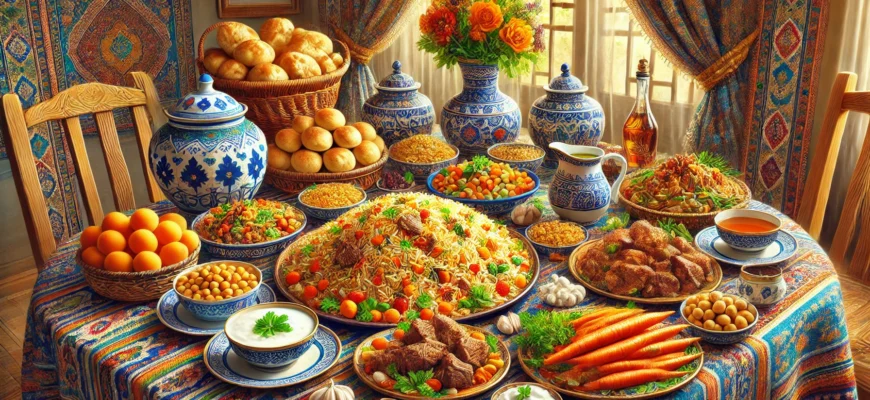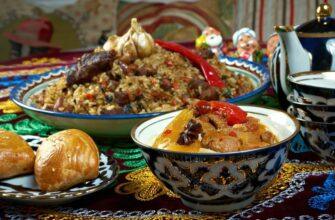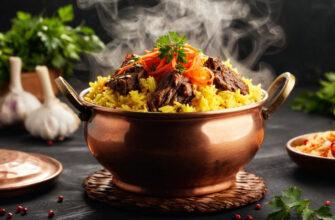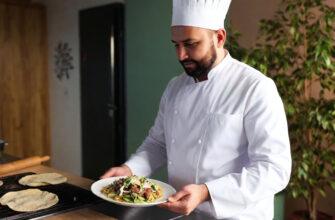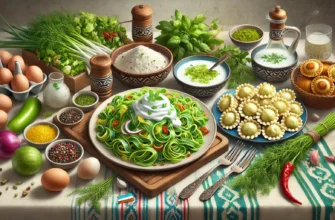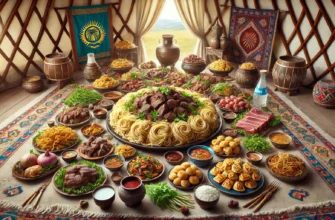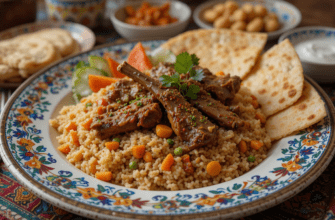Tajikistan, a land of majestic mountains and vibrant cultures, offers a culinary tapestry as rich and diverse as its landscapes. Nestled in Central Asia, this country boasts a cuisine heavily influenced by its neighbors, yet uniquely its own, characterized by hearty dishes and fragrant spices. From staple grains and savory meats to sweet delights, every bite provides a taste of Tajik tradition.
In this article, we embark on a flavorful journey, introducing you to essential Tajik dishes that define this nation’s gastronomic identity. You’ll discover the ingredients that form the backbone of Tajik cuisine, like rice, meats, and vegetables, used in beloved dishes such as Plov, Osh, and Laghman. We’ll explore the art of creating delicate dumplings and pastries, delve into the unique beverages that complement meals, and satisfy your sweet tooth with traditional desserts.
As we travel through the regions—Dushanbe, Khujand, and Khorugh—we’ll uncover both the influences and the distinct flavors each area brings to the table. We’ll also delve into the cultural customs of dining, where food is more than sustenance; it’s a shared experience steeped in hospitality and tradition. Join us as we savor the essence of Tajikistan through its essential dishes and discover the stories they tell.
Ingredients and Staples of Tajik Cuisine
Tajik cuisine reflects the country’s rich cultural tapestry and varied geography. This cuisine combines different flavors and techniques from surrounding Asian countries, such as Afghanistan and Uzbekistan. At its core, Tajik food relies on a selection of staple ingredients that define its distinct flavor profile. These ingredients include rice, a variety of meats, and fresh vegetables seasoned with traditional spices.
Rice as a staple
Rice is a central staple in Tajik cuisine, much like in other Asian dishes. It forms the foundation for popular dishes like osh (plov) and shirin polo (sweet rice). Tajikistan uses different varieties of rice, such as devzira and laser, to ensure the perfect texture for these meals. The rice is often fried with carrots and oil before boiling, giving it a beautiful golden brown hue. Sharing a large plate of rice dishes, like plov, is a common dining practice that reflects the Tajik gesture of hospitality and communal togetherness.
Common meats used in dishes
Meat plays a significant role in Tajik cooking, with lamb being the traditional favorite. You’ll often find pieces of meat served in popular foods alongside vegetables and rice. Beef and poultry are also staple meats, appearing in Tajik pilaf and other everyday dishes. Pork is never used due to religious customs. Mutton often fills samsa, a common regional snack. Various meats are featured in meals like kabob, qorma, and manti, providing a rich and hearty taste to the cuisine’s national foods.
Popular vegetables
Vegetables are another essential component of Tajik dishes. They add flavors and colors to the meals, ensuring a balanced diet. Onions, potatoes, garlic, and tomatoes are staples, especially in dishes like dimlama and qurutob, the latter being Tajikistan’s national dish. These vegetables, often accompanied by bell peppers, form the base of many stews and soups. Traditional salads in Tajikistan incorporate boiled carrots, cucumbers, and tomatoes. This vibrant array not only supports flavor but also brightens up every meal, reflecting the influence of Uzbek and broader Asian cuisines.
Signature Dishes of Tajikistan
Tajikistan’s cuisine reflects a blend of flavors influenced by its neighbors, especially Uzbekistan. Traditional foods here often include hearty dishes like plov and laghman, offering a taste of Central Asia’s culinary culture. Grilled meats, soups, and dairy products are staples in Tajik dishes, with rice, lamb, and spices like cumin as primary ingredients. Vegetables such as carrots and onions are also common, enriching the dishes with color and nutrition. Exploring Tajik cuisine offers a delightful blend of flavors and traditions, making each dish a delicious journey.
Osh/Oshi Palow
Osh, also known as oshi palov, is the national dish of Tajikistan. It is a popular dish throughout Central Asia. This rice dish combines pieces of meat, usually lamb or beef, with carrots, onions, and sometimes chickpeas and raisins. The mixture is cooked in a deg, a large cauldron, over an open flame. Each region adds its touch, with places like Panjakent famed for their use of yellow carrots. Oshi palow is not just a meal; it’s a gesture of hospitality. Served at celebrations, it unites family and friends. The aroma and taste make it a beloved symbol of Tajik hospitality.
Lubiyova
Lubiyova is a traditional soup unique to Tajikistan. It is made from beans and wheat ground together, offering a soft texture. The soup includes meat on the bone and sugar beets, giving it a slightly sweet taste. Making Lubiyova is a time-honored tradition, with families often preparing it in the evenings. The soup is left to steam overnight, allowing the flavors to develop. When ready, it is seasoned with parsley and celery and served on a tabaq. This delicious food reflects the rich cultural heritage of Tajik cuisine.
Laghman
Laghman is one of Tajikistan’s most popular foods, showcasing hand-pulled noodles served with beef and fresh vegetables. This delicious food can be prepared in a soupy form or as a dry pasta dish. The soupy version is like noodle soup, while the dry form resembles stir-fried noodles. Influenced by Uyghur and Dungan traditions, laghman celebrates the harmony of Asian dishes. Versions like Bozo Laghman, with fried noodles, and Gyozo Laghman, featuring boiled noodles, highlight the dish’s adaptability. Enjoyed across the country in many chaikhanas, laghman is a common dish loved by locals and visitors alike.
Plov
Plov, known as osh or palav in Tajikistan, is another rice dish intimately tied to the nation’s identity. Commonly found across Central Asia, it consists of rice, meat, and julienne-cut carrots. Sometimes chickpeas and raisins are added. This communal dish is cooked in a qazan, a large cauldron, and often seasoned with spices like cumin, salt, and black pepper. It is traditionally shared from a large plate, highlighting a cultural connection to Uzbek food. Regions like Khujand and Isfara are famous for their unique versions. Plov is more than sustenance; it’s a bond shared among friends and family.
Dumplings and Pastries
Tajik cuisine boasts a variety of delicious dumplings and pastries that are celebrated for their flavor and rich traditions. Among these, manti, samsa, Belyash, and tushbera stand out as popular Tajik dishes. These pastries and dumplings often feature robust fillings such as pieces of meat and onions, wrapped or folded into unique shapes. Tajik food, much like Uzbek cuisines, shares its roots with its Central Asian neighbors, yet retains its unique flavors. The preparation of these dishes often involves intricate marinating processes to enhance the taste and aroma, making them a true gesture of hospitality when shared with guests.
Mantu
Mantu is a cherished traditional dish in Tajik cuisine. It starts with making a dough that is rolled out thin and cut into small rectangles. These rectangles are then filled with seasoned beef, lamb, or chicken. The stuffing is folded to resemble a rose before being steamed to golden brown perfection. The steaming process requires special equipment, including a mantupaz, a large saucepan with a smaller pan of water. Mantu preparation is complex and usually involves at least two chefs, showcasing the pride Tajiks take in their national dish.
Sambusa
Sambusa, a popular Tajik pastry, is a favorite street food found across the country. It is usually filled with a savory mixture of meat and onions and cooked in a traditional clay tandoor oven. The basic dough for sambusa consists of flour, water, salt, and vegetable oil, with some variations using yeast. Sambusa comes in several forms, such as sambusa varaki with flaky pastry, and sambusa gijda made with a well-greased butter dough. Each variety offers a unique texture and taste, contributing to the rich tapestry of Tajik food. Nakhud sambusa, stuffed with chickpeas, is a special variety found in markets throughout Tajikistan, and it makes an excellent tasty snack for anyone exploring the region.
Unique Beverages
Tajikistan boasts an array of traditional beverages that embody the culture and climate of the region. From refreshing summer sips to comforting winter brews, these drinks are integral to daily life. Chalob, also known as dughob, is a cherished fermented dairy drink. It blends chakka with mineral water, mint, and salt, offering a unique taste. Compote, a fruit beverage, is another favorite. It’s made by boiling pieces of fruit and preserving them in a sugar syrup, with sour cherry being a popular choice. The country’s natural springs provide ample mineral water, which is enjoyed throughout Tajikistan. In the summer, cold lemonade offers relief from the heat at an affordable price. Tea, a staple beverage, is central to social gatherings, symbolizing hospitality and unity.
Shirchoy
Shirchoy is a beloved tea in Tajikistan and Central Asia. It combines black tea leaves with milk and butter, creating a rich and creamy drink. The process begins by boiling the tea leaves to form a strong brew. Milk and butter are then added, enriching the flavor and texture. This tea provides warmth and energy, making it perfect for chilly winter days. Not only does it offer nutrients, but Shirchoy also satisfies with its full-bodied taste. Its creamy richness is both comforting and invigorating. Enjoyed during family gatherings or casual moments, Shirchoy remains a mainstay in Tajik culture, offering both nourishment and warmth.
Traditional Tea Culture
The tea culture in Tajikistan is deeply woven into the fabric of social and family life. A tradition dating back centuries, it plays a vital role in gatherings and celebrations, symbolizing a gesture of hospitality and friendship. Green and black teas are the most favored, with black tea often served in the winter due to its warmth.
In Tajikistan, tea is brewed strong and dark, typically served in small glasses known as piala. These tiny cups hold powerful brews often sweetened with sugar or honey. Such preparation underscores the significance of tea as a social instrument, its consumption often accompanied by heartfelt conversations.
Beyond its role in social settings, tea is also valued for its health benefits. It’s believed to aid in digestion and is sometimes used for medicinal purposes. Whether for health or hospitality, tea’s presence in Tajik culture is both essential and enduring.
Desserts and Sweets
Tajik cuisine has a variety of desserts and sweets that mirror the country’s rich cultural history. They highlight the region’s influences and the emphasis on hospitality and sharing. Tea is a central part of Tajik meals and is often served with a selection of sweets such as puff pies and halvah. Traditional sweets often use ingredients like flour, nuts, and sugar syrup. The use of dried fruits and nuts is common, lending the dishes a natural sweetness. These desserts not only provide a sweet ending to meals but also showcase a welcoming gesture to guests.
Halvaitar
Halvaitar is a beloved Tajik dessert, inspired by Middle Eastern halva. This dessert is simple yet rich, made with flour and mutton fat. A sweet sugar syrup adds a delightful sweetness, and nuts are sometimes sprinkled on top. Halvaitar reflects the melding of local ingredients with external influences typical of Tajik sweet creations. The simplicity of its ingredients highlights the authenticity and traditional nature of this dessert. It is a clear example of how Tajikistan incorporates both its own flavors and global tastes, creating desserts that are rich in both history and taste.
Yak Milk Ice Cream
In the summer, a unique treat is available at the Murghab Bazaar: yak milk ice cream. Located behind the Megafon shop’s shipping container, an ice cream parlor serves this local delicacy. Yak milk offers a distinct taste, though it closely resembles cow’s milk ice cream. This dessert stands out due to its regional specialty status, offering a unique flavor experience. The ice cream shares similarities with traditional variants, making it a favorite for both locals and visitors looking for something different. Its presence in the bazaar highlights regional tastes and culinary practices, showcasing Tajikistan’s variety in traditional foods.
Influences and Regional Variations
Tajik cuisine stands as a delightful fusion of varied influences. The country’s culinary landscape is shaped by its Persian, Central Asian, and Russian ties. This blend results in an array of flavors and traditional dishes. Osh, a signature rice dish, exemplifies the Central Asian impact. Shashlik, a kind of kebab, highlights the shared techniques in this region. Each area in Tajikistan brings its own unique traits to the table. Ingredients depend heavily on what is locally available and seasonal, showcasing how regional variations create a diverse food culture.
Central Asian influences
Central Asian influences are deeply woven into Tajik cuisine. The Silk Road brought culinary traditions from Iran, China, Russia, and Afghanistan. These influences are evident in the diverse types of Tajik food. Notably, Tajikistan’s Muslim-majority status shapes the core of its food culture by prohibiting pork. Unlike other Central Asian nations, Tajik dishes incorporate generous portions of greens and herbs like fennel and mint. This provides a fresh note to the rich flavors. While unique, Tajik cuisine shares several popular dishes with its neighbors, emphasizing the interconnectedness within the region.
Regional specialties in Dushanbe
Dushanbe, the capital, offers a blend of traditional food and global flavors. This city embodies Tajikistan’s diverse culinary scene. Fragrant plov, a popular dish in Dushanbe, represents a warm gesture of hospitality. Its combination of rice, pieces of meat, raisins, and yellow carrots makes it savory. Manti, steamed dumplings filled with spiced meat, is another must-try delight. They are typically served with a tomato sauce and yogurt. Street food here is vibrant, with aromas from flaky flatbread and savory kebabs filling the air. These offerings highlight the city’s rich food culture.
Khujand’s unique offerings
In Khujand, the proximity to Uzbekistan and Kyrgyzstan influences the local flavors. The region’s lush Fergana Valley provides fresh vegetables and grains. Khujandi Kebab, a national dish, involves chunks of meat, dried fruits, and saffron, creating memorable flavors. Fresh herbs and dried fruits add sweet and savory contrasts to the dishes here. The hearty and bold culinary creations reflect the area’s natural abundance. This combination of regional ingredients and cultural influences makes Khujand a beacon of rich, delicious food.
Khorugh’s local flavors
Khorugh offers robust flavors with bold spices. The dishes in this region are hearty and vibrantly seasoned. Khorughi Plov is a standout, featuring rice and lamb enhanced with raisins and carrots. It differs from other plov versions with its unique taste. The local twist on kebabs, known as Khorughi Kebab, ups the spice level. Tikka-e-Khorugh showcases grilled skewers of marinated meat, often paired with naan. Another highlight is Qorma-e-Khorugh, a yogurt-based meat stew. Its special spice blend makes it a flavorful delight. These dishes emanate warmth and are a testament to Khorugh’s rich culinary heritage.
Cultural Aspects of Dining
Tajik cuisine reflects the country’s diverse history and cultural influences. Persian, Central Asian, and Russian culinary traditions have shaped it over time. One distinct aspect is communal dining, where food like osh, a national dish, is served on large plates for sharing. Bread plays a vital role in Tajik food, often used to scoop up stews. Fresh herbs and dairy products enrich the strong flavors in Tajik dishes. Nuts, such as almonds and pistachios, add texture and flavor. The dining experience in Tajikistan is not only about food but also about sharing culture and community by dining together.
Communal eating customs
Communal eating in Tajikistan is a cherished tradition. Meals like plov and qurutob are shared from a big communal plate, known as tabak. In rural areas, it is common to eat with one’s hands, fostering a sense of closeness among diners. Meals are social events, with tea often served. Offering tea to guests is a gesture of hospitality, embodying the warmth of Tajik culture. The dining table, or dastarkhan, holds cultural importance. It symbolizes unity and the communal essence of eating in Tajik culture, highlighting how food brings people together.
Importance of bread (Non)
Bread, especially the flatbread known as Non, is essential in Tajik meals. Non is large, round, and baked in a tandoor oven. It’s a staple found in markets and street vendors across Tajikistan. Various types of Non exist for different occasions. Girdacha is the largest flatbread, while fatir is flaky and cooked in oil, and kulcha is a fluffy variety. Non holds cultural significance, with customs such as not cutting it with a knife or placing it upside down, as these acts are considered bad luck. In Tajikistan, Non, or noni garm, meaning “warm bread,” is an everyday sight, underscoring its importance and ubiquity in the region.
Conclusion: A Culinary Journey Through Tradition and Flavor
Tajik cuisine offers a flavorful journey through tradition and culture. With robust flavors and hearty portions, Tajik food uses fresh herbs, dairy products, and a diverse range of spices. Bread and tea are essential in daily meals, symbolizing hospitality and community.
One of the most celebrated Tajik dishes is plov, also known as pilau. This rice dish is a staple across Central Asia. The Tajik version often includes dried fruits, peas, and garlic, creating a delicious blend of flavors. Other popular foods like kabobs, mantis, and samsas highlight Tajik cuisine’s use of spices and meats.
A national dish to note is qurutob, a unique traditional dish. It uses qurut, a salty dairy base, mixed with flatbread and fresh vegetables. This common dish is a true delight.
Key Elements of Tajik Cuisine:
- Staples: Bread and tea
- Popular Dishes: Plov, Qurutob
- Flavor Elements: Fresh herbs, dairy, spices
- Common Ingredients: Chunks of meat, vegetables, garlic
Tajik cuisine successfully combines traditional foods with delicious, rich flavors, offering a unique culinary experience that reflects the heart of Tajikistan.

